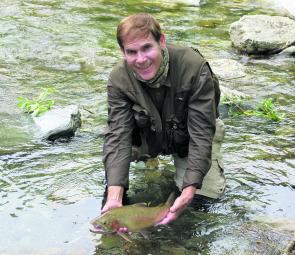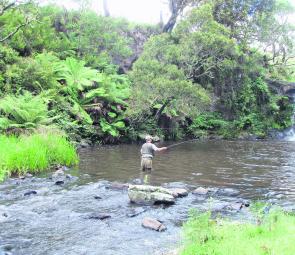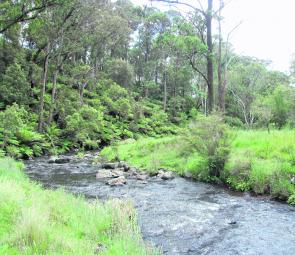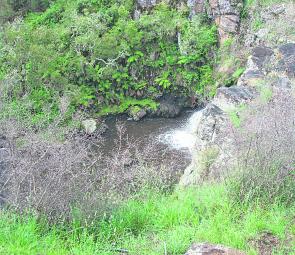The rainfall was perhaps a little tardy in the New England area after the 2012/2013 trout season opened. However, in the last few months most, if not all, high country streams have been running up into the surrounding grass on a regular basis. For the fly angler this mean that pre-spawning trout are in a feeding frenzy.
Rising water sees food washed in; an abundance of food promotes regular feeding which then benefits the angler. Feeding trout in small waters are easily seen and just as easily cast to; but not necessarily landed…
New England trout streams are easily enough found on the Internet, via good old Google. As is always the case with trout streams some waterways seem to fish better than others in any given year but if the main activities are centred around the Ebor area – west of Coffs Harbour via Dorrigo, east of Gurya on the New England Highway – new chums and old hands alike should not go far wrong.
Most of the dozen or more trout streams around Ebor are on private property so remember to seek permission to fish; head to the nearest house next to the chosen stream. From my experience refusals are rare, and then usually only because of a good reason.
As a good tip, the further from the car the better the fishing. Gorges are very good places to fish at Ebor.
Fishing at an altitude of over 1000m in mid autumn will see cool days and cold, frosty nights. Warm clothing all round is the key, along with a good quality sleeping bag or swag when it’s time for some shut eye.
A typical day kit will consist of: jeans or similar trousers worn; a warm shirt with a pullover or sweater to keep the upper body warm; gum boots or thigh waders to keep feet as dry as possible; and a back pack containing water, spare clothing, some tucker and a rain coat.
A fishing vest will carry fly boxes, tippet material, line cutters, hook removers, fly line floatant (such as Mucilin) and fly floatant as well. A NSW fishing license can also obtained online.
Ebor waters are small in comparison to those of the Snowy Mountains area or the high country of Victorian, so long casts are unlikely. In fact, the stealth approach is much more important than casting skills in most instances.
Nevetheless, fishing too light can also cause complications, especially while trying to manage lively rainbows in and around snags and other obstructions.
A 5-6wt (the ‘weight’ of a fly rod is an indicator of strength) rod is sensible and should be matched to a reel with a similar weight, floating fly line plus some backing on it. Choice of a fly line usually revolves around the state of the wallet but there’s little doubt that the more a fly line costs the better it casts and lasts. Double or single taper? Most anglers these days opt for the single taper given their terrific casting ability but there’s nothing wrong with a double taper. Once an end starts to exhibit a series of cracks or becomes rough to the touch the line can be reversed on the reel and the other end brought into use. Backing for stream trout usually sees around 50m of Dacron or very heavy braid being set up on the reel behind the fly line.
Choosing the correct fly for the situation always involves imitating food the fish predominately eat, therefore some similarity to insects such as mayflies, beetles or grasshoppers is important when considering New England dry flies.
Selecting an Adams, Iron Blue Dun, Royal Wulff, Wickhams Fancy, to imitate our mayflies (sizes 14, 16), or perhaps a Humpy, Red Tag, or Geehi Special (sizes 14, 12) to imitate a floating beetle; sizes 12 and 10 for the ‘hoppers which can best by imitated by patterns such as the Glen Innes Hopper, Nobby Hopper or the always handy Muddler Minnow.
All of these flies may be cast close to a fish seen rising to the surface. Watch the fly disappear as a fish takes it before smartly lifting the rod to set the hook. A landing net at the end of proceedings will be very useful.
Beetles offer good wet fly patterns, one of the best being brown or black beetles in size 10 or 12.
Nymphs, the larval form of many insects, are great fish takers and black or brown seal’s fur nymphs in size 14 and 16 are worth having in the fly box. These flies are used when fish are perhaps bulging the water’s surface but not showing their heads to take food directly from the surface. In such cases, the fish are ‘nymphing’ rather than ‘rising’. The nymph is cast near a fish and the leader tippet watched closely. If it draws, a fish has the fly!
New England wet flies, as distinct from nymphs, are useful if streams are flooded and the water is somewhat discoloured. Wets can imitate small fish, leeches, a drowned grasshopper or merely represent something that needs to be tasted because it is moving erratically.
Wet flies are cast upstream and then retrieved in small jerks and twitches with the angler alert for a hit. Some excellent wet flies are the Woolly Worm, Woolly Bugger, Matuka, Alexandra and Bunny Fly, all in sizes 6 or 8.
New England is definitely worth the effort at this time of year. Fish always feed heavily just before spawning and with the streams in such good condition fly fishing prospects are excellent.
Reasonable weather is a bonus but weather – other than serious rain – has little influence in the gorges at Ebor, so if the day is a little showery a raincoat or poncho should still see the rod in action. Be aware that in fast, shallower, water it will be the deeper sections that hold the trout.
Reads: 4738
The fat rainbow trout held by the author is typical of those in many New England streams at the present time.

Gorge country is trout country in the New England region.

In fast, shallow, water it’s the deeper sections that will hold the fish.

The effort of getting down to that pool will likely be rewarded with a fat rainbow trout or two.




